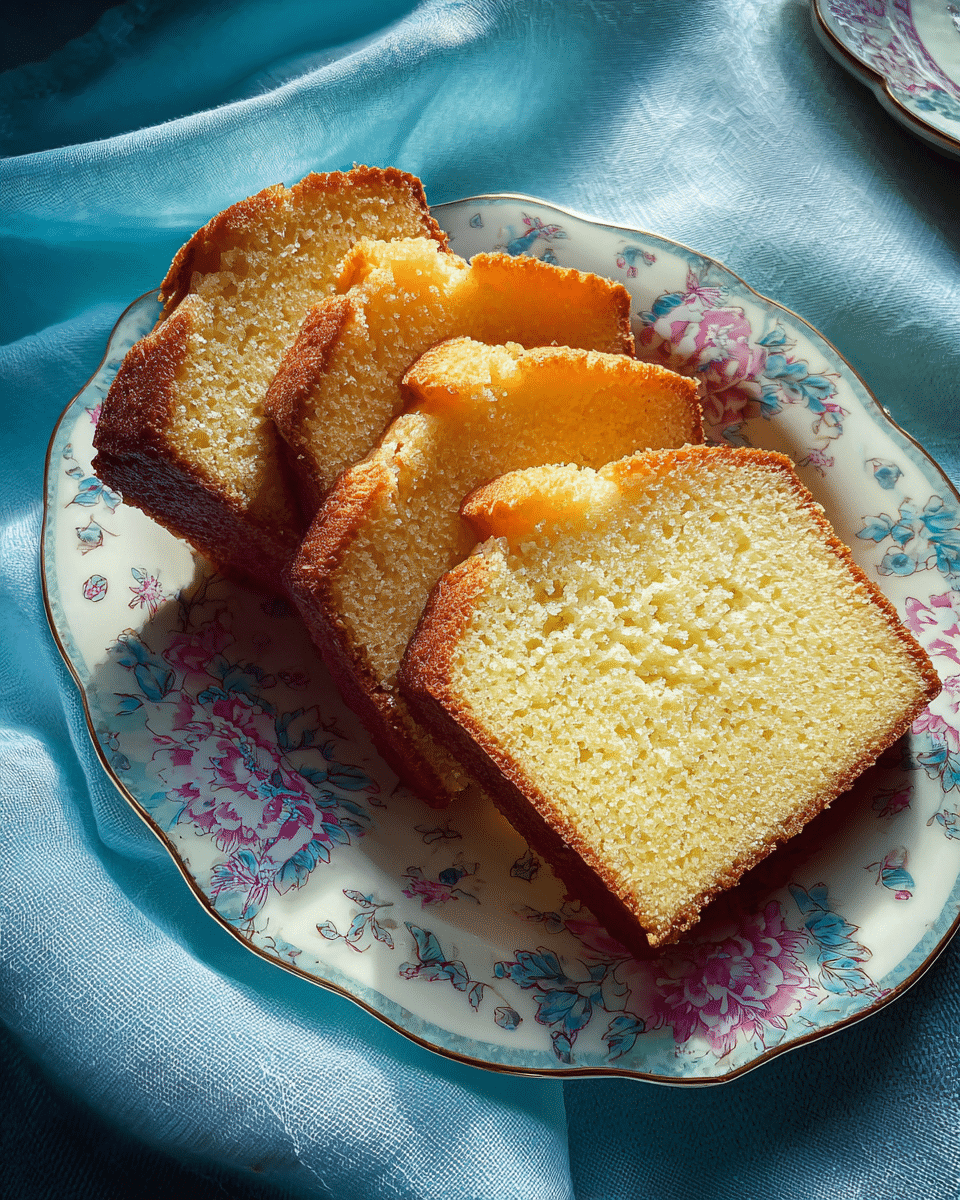This Easy Homemade Pound Cake is a treasured recipe passed down from Grandma’s kitchen, known for its buttery richness, golden crust, and perfectly dense crumb. With just a handful of pantry staples and simple steps, you can recreate this timeless classic that pairs wonderfully with fresh berries, whipped cream, or a drizzle of glaze. It’s the perfect cake for holidays, family gatherings, or just a comforting treat with your afternoon coffee.
FULL RECIPE
Ingredients
- 2 cups (450 g) unsalted butter, softened
- 3 cups (600 g) granulated sugar
- 6 large eggs, room temperature
- 3 cups (375 g) all-purpose flour
- 1 teaspoon baking powder
- 1/2 teaspoon salt
- 1 cup (240 ml) whole milk, room temperature
- 2 teaspoons pure vanilla extract
Directions
- Preheat your oven to 325°F (165°C). Grease and flour a 10-inch bundt or tube pan, tapping out any excess flour.
- In a large mixing bowl, cream the softened butter and granulated sugar together using an electric mixer on medium speed until light and fluffy, about 4–5 minutes.
- Add the eggs one at a time, mixing well after each addition to ensure the batter stays smooth.
- In a separate bowl, whisk together the all-purpose flour, baking powder, and salt.
- Gradually add the dry ingredients to the creamed mixture, alternating with the whole milk. Begin and end with the dry ingredients, mixing just until combined after each addition.
- Stir in the vanilla extract until evenly distributed.
- Pour the batter into the prepared pan, smoothing the top with a spatula.
- Bake for 70–80 minutes, or until a toothpick inserted into the center comes out clean.
- Allow the cake to cool in the pan for 15 minutes, then carefully remove and place on a wire rack to cool completely before slicing and serving.
Nutrition Facts
- Serving Size: 1 slice (1/12 of cake)
- Calories: 560
- Total Fat: 29g
- Saturated Fat: 17g
- Cholesterol: 165mg
- Sodium: 220mg
- Total Carbohydrates: 70g
- Dietary Fiber: 1g
- Sugars: 44g
- Protein: 7g
The History of Pound Cake
Pound cake dates back to the 18th century and was named for its original recipe, which called for one pound each of flour, butter, sugar, and eggs. This simple, straightforward method made it easy for bakers to remember the proportions, resulting in a rich, dense cake that was both filling and delicious. Over time, variations have evolved, but the core idea of a buttery, pound-for-pound cake remains central to its identity. It has become a staple in many households, appreciated for its timeless flavor and texture.
Key Characteristics of Pound Cake
A traditional pound cake is known for its dense, moist crumb and a tender, buttery flavor that isn’t overly sweet. Unlike lighter cakes that rely heavily on leavening agents, pound cakes depend primarily on the air incorporated during creaming the butter and sugar, and the eggs’ structure to rise slightly. This results in a cake that feels substantial and satisfying, making it an excellent choice for pairing with a variety of toppings or accompaniments.
Why Butter is Essential in Pound Cake
Butter plays a crucial role in pound cake, contributing to its rich flavor and moist texture. Using unsalted butter allows for better control over the salt content, balancing the sweetness and enhancing the overall taste. Butter also helps create the cake’s characteristic tender crumb by coating flour proteins and limiting gluten formation. Additionally, the creaming of butter and sugar incorporates air, which provides some lift to the dense batter.
The Role of Eggs in Pound Cake
Eggs are vital in pound cake as they provide structure, moisture, and richness. The large eggs contribute protein that helps the cake hold its shape while trapping air bubbles during mixing, aiding in leavening. Egg yolks add fat and enhance the tenderness of the crumb, while the egg whites contribute to the overall stability. Using room temperature eggs ensures they blend smoothly into the batter, preventing it from curdling and producing a uniform texture.
Flour Selection and Its Impact
All-purpose flour is the most commonly used flour for pound cake, striking a balance between tenderness and structure. Using cake flour, which has less protein, can create an even softer and lighter texture, while bread flour, with higher protein, can make the cake tougher. The choice of flour influences how much gluten develops during mixing, which directly affects the crumb’s density and chewiness, making flour an important factor in achieving the ideal pound cake consistency.
Variations to Customize Your Pound Cake
While the classic pound cake is delicious on its own, there are numerous variations that can be made to suit different tastes. Adding citrus zest, such as lemon or orange, infuses fresh, bright flavors. Incorporating spices like cinnamon or nutmeg brings warmth and complexity. Swirling in chocolate or folding in berries introduces texture and bursts of flavor. You can also experiment with different extracts, like almond or coconut, to create unique profiles while maintaining the cake’s classic richness.
Serving Suggestions and Pairings
Pound cake is incredibly versatile when it comes to serving. It can be enjoyed plain, allowing its buttery flavor to shine, or dressed up with toppings like whipped cream, fresh fruit, or a simple glaze. For a more indulgent treat, it pairs beautifully with ice cream or custard. Its dense texture makes it ideal for soaking up syrups, such as fruit compote or coffee syrup, adding moistness and additional flavor layers.
Storage Tips to Keep Pound Cake Fresh
To maintain the freshness of pound cake, it should be stored properly. Wrapped tightly in plastic wrap or stored in an airtight container at room temperature, it will stay moist for about 2 to 3 days. For longer storage, freezing slices individually wrapped in plastic and then foil helps preserve its texture and flavor for up to 3 months. When ready to eat, thaw the cake at room temperature or gently warm it for that just-baked feel.
Health Considerations and Nutritional Information
Pound cake is a rich dessert with a high butter and sugar content, which makes it calorie-dense and high in saturated fat. While it’s not typically considered a health food, enjoying it in moderation can fit within a balanced diet. Those watching their sugar or fat intake might consider smaller portions or lighter versions made with substitutions like yogurt or applesauce, though these may alter the classic texture and flavor.
Common Baking Tips for Success
Achieving the perfect pound cake requires attention to detail. Make sure all ingredients are at room temperature to ensure smooth mixing and prevent curdling. Avoid overmixing once the flour is added to keep the crumb tender. Using the right pan size and preparing it well by greasing and flouring ensures easy release. Baking at a moderate temperature helps the cake cook evenly without drying out, and testing doneness with a toothpick ensures it’s perfectly baked.
Cultural Significance and Popularity
Pound cake holds a cherished place in many cultures around the world. In the United States, it is often linked to Southern hospitality and traditional family gatherings. It has become a symbol of homemade comfort and heritage, passed down through generations. The cake’s straightforward ingredients and preparation make it accessible for home bakers, while its rich flavor makes it a festive choice for celebrations and holidays worldwide.
Conclusion
Easy homemade pound cake is more than just a dessert; it’s a timeless tradition that brings warmth and comfort to any table. Its simplicity, versatility, and rich flavor make it a favorite for all occasions. Whether enjoyed plain, dressed up with toppings, or customized with variations, this cake continues to delight generations of bakers and eaters alike. With proper care in preparation and storage, pound cake remains a reliable, delicious treat that embodies the essence of classic baking.






